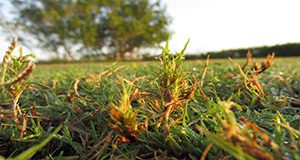Abstract
The bermudagrass mite, Eriophyes cynodoniensis (Sayed) (Arthropoda: Arachnida: Eriophyidae), also known as the couch grass mite, can be a serious pest of bermudagrass in multiple high-maintenance turf systems such as sod production, athletic fields, and golf courses. Mites cause leaf and bud galls, which can lead to severe aesthetic damage and plant decline or death in high-maintenance areas with low tolerance for plant damage. In this 7-page fact sheet written by Pablo Agustin Boeri, Nicole D. Benda, J. Bryan Unruh, and Adam Dale and published by the UF/IFAs Entomology and Nematology Department, review the biology, identification, and management of the bermudagrass mite, and get specific management recommendations based on evidence from UF/IFAS research.
https://edis.ifas.ufl.edu/in1217
References
Baker, W. E., T. Kono, and N. R. O'Neill. 1986. "Eriophyes zoysiae (Acari: Eriophyidae), a new species of eriophyid mite on zoysiagrass." International Journal of Acarology. 12: 3-6. https://doi.org/10.1080/01647958608683432
Beehag, G. W. 1992. "Couchgrass culture in Australia." Turf Notes. 11: 10-11.
Buss, E. A. 2008. Bermudagrass Mite. ENY-328. Gainesville: University of Florida Institute of Food and Agricultural Sciences. http://ufdcimages.uflib.ufl.edu/IR/00/00/28/49/00001/LH03500.pdf.
Buss, E., and A. G. Dale. 2016. Landscape Integrated Pest Management. ENY-298. Gainesville: University of Florida Institute of Food and Agricultural Sciences. http://edis.ifas.ufl.edu/in109.
Casler, M. D., and R. R. Duncan. 2003. Turfgrass Biology, Genetics, and Breeding. pp. 235-256.
Christians, N. E., A. J. Patton, and Q. D. Law. 2017. Fundamentals of Turfgrass Managment. Fifth ed. John Wiley & Sons, Inc. https://doi.org/10.1002/9781119308867
Cromroy, H. L. 1983. "Potential use of mites in biological control of terrestrial and aquatic weeds." In Hoy, M. A., G. L. Cunningham, And L. Knutson (eds) Biological control of pests by mites. Univ. Calif. Division Agric. Nat. Resources, Special Pub. 3304: 61-66.
De Lillo, E., and R. Monfreda. 2004. "'Salivary secretions' of eriophyoids (Acari: Eriophyoidea): first results of an experimental model." Experimental and Applied Acarology. 34: 291-306. https://doi.org/10.1023/B:APPA.0000049219.93796.11
Haydu, J. J., A. W. Hodges, and R. C. Hall. 2006. Economic Impacts of the Turfgrass and Lawncare Industry in the United States. FE-632. Gainesville: University of Florida Institute of Food and Agricultural Sciences. http://edis.ifas.ufl.edu/fe632
Jeppson, L. R., H. Keifer, and E. W. Baker. 1975. Mites Injurious to Economic Plants. University of California Press. pp. 333-450.
Johnson, F. A. 1975. "Bermudagrass mite, Eriophyes cynodoniensis Sayed (Acarina: Eriophyidae) in Florida with reference to its injury symptomology, ecology, and integrated control." Ph.D. Dissertation, University of Florida, Gainesville. https://doi.org/10.5962/bhl.title.49742
Keifer, H. H., E. W. Baker, T. Kono, M. Delfinado, and W. E. Styer. 1982. "An Illustrated Guide to Plant Abnormalities Caused by Eriophyid Mites in North America." United States Department of Agriculture, Agriculture Handbook No. 573, p. 84.
Kneebone, W. R. 1966. "Bermudagrass-Worldly, Wily, Wonderful Weed." In Proc. Scotts Turfgrass Res. Conf. Vol. 4, Turfgrass Breeding. Ceon. Bot. 20: 94-97. https://doi.org/10.1007/BF02861931
Reinert, A. J., C. M. Taliaferro, and J. A. McAfee. 2008. "Susceptibility of bermudagrass (Cynodon) varieties to bermudagrass mite (Eriophyes cynodoniensis)." Proc. II IC on Turfgrass. Acta Hort. 783, ISHS, pp. 519-528. https://doi.org/10.17660/ActaHortic.2008.783.53
Reinert, J. A. 1983. "The Bermudagrass Stunt Mite." USGA Green Section Record 20(6): 9-12.
Sabelis, M. W., and J. Bruin. 1996. "Evolutionary ecology: life history patterns, food plant choice and dispersal." In: Lindquist, E. E., M. W. Sabelis, and J. Bruin. (eds) Eriophyd mites: their biology, natural enemies and control. Elsevier Science Publishing, Amsterdam (World Crop Pests, Vol. 6, pp. 329-366). https://doi.org/10.1016/S1572-4379(96)80020-0
Salisbury, F. B., and C. W. Ross. 1985. Plant Physiology. Third ed. Wadsworth Publishing Company.
Smith, L., E.. De Lillo, and J. W. Amrine Jr. 2009. "Effectiveness of eriophyid mites for biological control of weedy plants and challenges for future research." Experimental and Applied Acarology. 51: 115-149. https://doi.org/10.1007/s10493-009-9299-2
Sternhcht, M., and S. Goldenberg. 1971. "Fertilisation, sex ratio and postembryonic stages of the citrus bud mite Aceria sheldoni (Ewing) (Acarina, Eriophyidae)." Bulletin of Entomological Research. 60: 391-397. https://doi.org/10.1017/S000748530004030X
Szczepaniec, A., and M. J. Raupp. 2012. "Effects of Imidacloprid on Spider Mite (Acari: Tetranychidae) Abundance and Associated Injury to Boxwood (Buxus spp.)." Arboriculture & Urban Forestry. 38: 37-40.
Trenholm, L., J. B. Unruh, and T. W. Shaddox. 2005. Bermudagrass for Florida Lawns. ENH-19. Gainesville: University of Florida Institute of Food and Agricultural Sciences. http://edis.ifas.ufl.edu/lh007
Watschke, T. L., H. P. Dernoeden, and D. J. Shetlar. 1995. Managing Turfgrass Pests. Lewis Publishers.
Wilson, N. S. 1959. "Eight new species of eriophyid." Ann. Am. Entomol. Soc. 52: 141-149. https://doi.org/10.1093/aesa/52.2.141
Unless otherwise specified, articles published in the EDIS journal after January 1, 2024 are licensed under a Creative Commons Attribution-NonCommercial-NoDerivs 4.0 International (CC BY-NC-ND 4.0) license.


